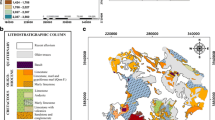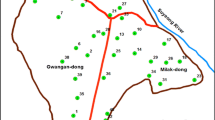Abstract
The current research has been conducted to evaluate groundwater aquifers qualitatively in the area located in the Western side of Qena city. The Quaternary aquifer represents the main groundwater source in the study area. It exists under unconfined to semiconfined conditions at depths varying between 4 m due North and 80 m in the South. The chemical analyses of the groundwater samples indicate that 77% of the total samples are fresh and 20% are brackish, while only 3% are saline. In addition, the iso-salinity contour map indicates that the salinity increases towards the central and northern parts of the study area. The total and permanent hardness increase as water salinity increases and vice versa in case of temporary hardness in the groundwater samples. The chemical water types and the ion ratios indicate meteoric origin of groundwater as well as the dissolution of terrestrial and marine salts. The contribution of recent recharge from the River Nile to a few groundwater wells in the study area varies from low to high. In addition, the most recharge sources are from the precipitation. Nitrate concentrations in groundwater increase towards the central and Northern areas significantly elevated in response to increasing anthropogenic land uses. Much of the solutes and physicochemical parameters in these waters are under the undesirable limits of World Health Organization (WHO) for drinking purpose, and a plot of sodium adsorption ratio versus EC shows that about 23% of the groundwater samples are good water quality, about 45% of groundwater samples are moderate quality, and 23% of the groundwater samples are intermediate water class, while the rest of samples (9%) are out of the range.








Similar content being viewed by others
References
Abdel Razik, T.M. and Razvaliaev, A.V., 1972, On the Tectonic Origin of the Nile Valley between Idfu and Qena, Egypt. Egyptian Journal of Geology, v. 16, no
Aggour, T.A., Hassanein, A.M., and Shabana, A.R., 2005, Flood control and hydrogeology of dandara area, west Nile valley, Qena. geology department, desert Research center, under printing
American Society for Testing and Materials, ASTM., 2002, Water and environmental technology. Annual book of ASTM standards
Burdon DJ (1958) Metasomatism of groundwater at depth. UNESCO course on hydrogeology, Desert Institute, Cairo, Egypt
Chebotarev I.I., 1955, Metamorphism of natural waters in the crust of weathering. Geochemica et. Cosmochimica Acta, 8(I):22–48, (II), PP 137–170 and (III), PP 198–212
Egyptian Geological Survey and Mining Authority, EGSMA, 1978, Geologic map of the Aswan quadrangle, scale 1:500000, Egypt
El-Hussaini, A.H., El-younsy, A.R., Ibrahim, H.A., Bakheit, A.A., Omran, A.A., and Abd ElAaty, A.H., 1992, Geological and surface geoelectrical investigations on the area southwest of Qena, Western Desert, Egypt. Bull. Fac. Sci,., Assiut univ., pp. 89–103
El-kadi, A.I., Plummer, N.L., and Aggarwal, P., 2010, NETPATH-WIN: An Interactive User Version of the Mass-Balance Model, NETPATH. Department of Geology and Geophysics and Water Resources Research Center, University of Hawaii at Manoa, Honolulu, Hawaii 96822; (808) PP 956–6331
El Sabri, M.A.Sh., 2010, Impact of intensive land reclamation activity on shallow groundwater aquifer in the area between el Waqf and Dandara, west nile vally, Qena. Fac. Sci., Assuit Univ. J of geology 39(2), P-P 57-77
Fayez, M.S., 1993, Hydrogeological and hydrochemical studies on some localities in South Eastern Desert. Egypt. Ph.D. Thesis. Suez Canal Univ., Egypt, 314 P
Fishman, M.J. and Friedman, L.C., 1985, Methods for determination of inorganic substances in water and fluvial sediments. U.S. Geol. Surv. Book 5,Chapter A1.Open File Report 85–495, Denver, Colorado, U.S.A (84)
Freeze RA, Cherry JA (1979) Groundwater. Prentice Hall, Inc., Englewood Cliffs.
Geriesh, M.H., 1998, Hydrogeological Assessment of the Groundwater Resources around the Nile Valley between Qift and Nag-Hammadi, Upper Egypt. Al-Azhar bull. Sci.,vol. 9 no. 1
Hem, J.D., 1970, Study and interpretation of the chemical characteristics of natural water, (2d ed.): US Geological Survey Water-Supply Paper No 1473, 363 p
Hem, J.D., 1992, Study and interpretation of the chemical characteristics of natural water, (3d ed.): US Geological Survey Water-Supply Paper 2254, 263 p
Jeevanandam M, Kannan R, Srinivasalu S, Rammohan V (2007) Hydrogeochemistry and groundwater quality assessment of lower part of the Ponnaiyar River basin, Cuddalore district, South India. Environ Monit Assess 132(1–3):263–274. doi:10.1007/s10661-006-9532-y
Jung YY, Koh DC, Yu YJ, Ko KS (2010) Analysis of groundwater flow systemsfor springs in the southern slope of Jeju Island using hydrogeochemical parameters. J Geol Soc Korea 46:253–273
Koh DC, Ha K, Lee KS, Yoon YY, Ko KS (2012) 2012, flow path and mixing properties of groundwater using hydrogeochemistry and environmental tracers in the southwestern area of Jeju volcanic island. J Hydrol 432-433:61–74
Mckee, J. E. and Wolf, H.W., 1963, Water quality criteria. California state water quality board, Publ., 3A., U.S.a.
Omran AA, Riad S, Philobbos ER, Othman AB (2001) Subsurface structures and sedimentary basins in the Nile Valley area as interpreted from gravity data, Egypt. J Geol 45/1:681–712
Pawellek F, Frauenstein F, Veizer J (2002) Hydrochemistry and isotop geochemistry of the upper Danube River. Geochim Cosmochim Acta 66:3839–3854
Rainwater, F.H. and Thatcher, L.L., 1960, Methods for collection and analysis of water samples. U. S. Geol. Survey water supply, 301P
Richard, L.A., 1954, Diagnosis and improvement of saline and alkali soils. US Department of Agriculture Hand Book, vol 60
Said R (1962) The geology of Egypt. Elsevier publishing Co., Amsterdam, New York, 337 p
Said, R., 1991, The geology of Egypt. A. A. Balkema, Pub Rotterdam, 734 P
Starinsky, A., Bielski, M.., Ecker, A., and Steinitz, G., 1983, Tracing the origin of salts in groundwater by Sr isotopic composition (the crystalline complex of the southern Sinai), Egypt. Isot Geosci, (1), PP 257–267
Stigter TY, Van Ooijen SPJ, Post VEA, Appelo CAJ, Dill AMMC (1998) A hydrogeological and hydrochemical explanation of the groundwater composition under irrigated land in a Mediterranean environment. Algarve Portugal J Hydrol 208:262–279
WHO (2008) Guidelines for drinking water quality. World Health Organization, Geneva
Zaghloul, M.T., 2006, Geoelectrical evaluation for groundwater setting in el Marashda area, Qena, Egypt. Msc. Fac. of Science, Al Azhar University, 100 p
Author information
Authors and Affiliations
Corresponding author
Rights and permissions
About this article
Cite this article
Mohallel, S.A., Gomaa, M.A. Studying the impacts of groundwater evolution on the environment, west Qena city, Egypt. Arab J Geosci 10, 372 (2017). https://doi.org/10.1007/s12517-017-3151-5
Received:
Accepted:
Published:
DOI: https://doi.org/10.1007/s12517-017-3151-5




